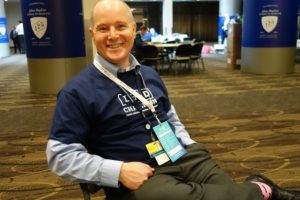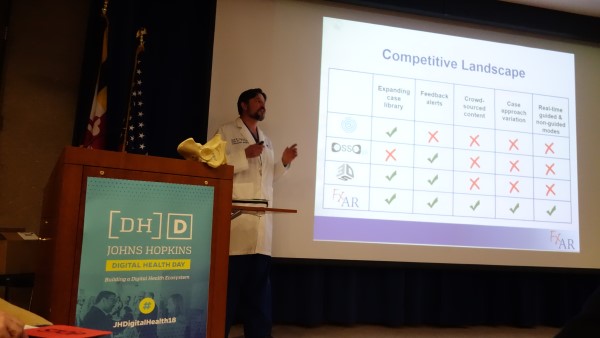
An iPad programmed to offer hospital patients personalized information about their treatment and lab results and an augmented reality training system for repairing fractures were among innovations featured at Johns Hopkins Medicine’s Digital Health Day on Dec. 13. Sponsored by the Johns Hopkins Technology Innovation Center (TIC), the daylong event was held in Turner Concourse.
Paul Nagy, deputy director of TIC, described the event as a “one-stop shop for the art of the possible.” It offered 13 workshops, product/tech pitches and networking for nearly 250 health technology innovators, research groups and potential investors.
“There are a lot of different organizations across Johns Hopkins interested in digital health,” Nagy says. “There are so many physicians who want to explore new relationships with patients through digital health.”
Workshop topics at the second annual event included how to plan for clinical evaluation of a technology, how to incorporate telemedicine into a clinical practice, and how to build apps that work with hospital systems. The program also provided “big picture” perspectives available with population health analytics and beginning business advice, such as how to pitch an idea to prospective customers.
One session focused on the capabilities of MyChart Bedside, an app loaded onto iPads at all 850 in-patient adult beds at The Johns Hopkins Hospital. The app allows patients to track their vital signs and medications, and to view lab results, which is the most-used feature according to Alisa Sabunciyan, senior project manager for the Epic application team.
Patients also can look up information about their treatment team and medical procedures, as well as take notes or videos during their stay at the hospital. For patients who have a free Johns Hopkins MyChart account or sign up for one on the free MyChart Bedside app, the information is also available after being discharged. The app bridges the support between hospital and home, replacing the “bankers’ box of papers” that patients typically receive, Sabunciyan says.
The iPads will be used in a pilot program at Johns Hopkins Bayview Medical Center later this month and will be at all in-patient adult beds at Sibley Memorial Hospital early this year. By the end of fiscal 2020, more than 2,000 iPads will be at hospitals across Johns Hopkins Medicine, according to Sabunciyan.
It’s a win-win situation: “It makes (clinicians’) time with patients more effective and targeted,” says Jawadali Ahmed, project lead for the Epic application team.
MyChart Bedside points to the growing interest in digital health — the idea that technology can help solve clinical problems and that software engineers can help improve hospital workflow and patient experience.
Digital health also can affect people before they become patients through, for example, wearable sensors (such as Fitbits) and mobile health-care apps that empower people to track, diagnose and improve their overall health and well-being.
Digital health remains at an early-adopter stage at Johns Hopkins, according to Nagy, with mostly engineering projects integrated into digital health records. He says TIC’s push for more innovation fits nicely with Johns Hopkins’ focus on precision medicine, as both seek improved treatment options for better patient care.

To encourage such projects, TIC created Hexcite (Excited for Health), a four-month program in which teams of Johns Hopkins entrepreneurs can launch startups while receiving expert advice and assistance. Participants also can run a clinical pilot program at The Johns Hopkins Hospital. During the Digital Health Day event, the teams pitched their innovations to attendees and received feedback from a panel of health care information technology entrepreneurs and investors.
Among the projects: A patient case review prioritization system for hospital chief financial officers; a patient safety analytics tool; a real-time coordination platform for sepsis care; and a program to help hospitals get higher ratings from the Centers for Medicare & Medicaid Services by collecting better and more accurate information.
The winning Hexcite pitch belonged to FxAR (Fracture AR), which creates augmented reality training for doctors who perform surgery to repair fractures. The project is supported by the Department of Art as Applied to Medicine.
Greg Osgood, chief of orthopaedic trauma in the Department of Orthopaedic Surgery, has worked in augmented reality research for years and was excited to see so many vendors on Digital Health Day.
“We’ve been working with digital medicine for a long time,” the surgeon says. “It’s interesting to see it taking off and all the things you can do.”
He says the FxAR team decided to apply for Hexcite after receiving grant money for its engineering work. The program instructed team members about such business school topics as marketing strategies, branding, product timeline and managing expectations.
Getting clinicians to think like entrepreneurs is the ultimate goal of Digital Health Day, Nagy says. “If someone came in with an idea, I want them to leave with a project plan,” he says.
Formed in 2014, the TIC is a group of software developers who collaborate with clinical leaders, researchers and technologists to create digital applications that can improve patient safety and enhance the quality of their experience. So far, the group has developed more than 40 applications.
The TIC organized Digital Health Day along with the Global mHealth Initiative, the Division of Health Sciences Informatics, the Malone Center for Engineering in Healthcare and the Center for Bioengineering Innovation and Design.